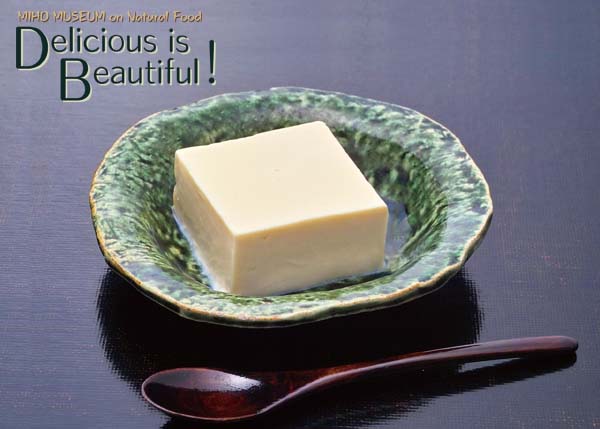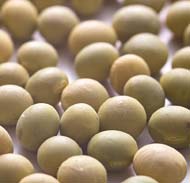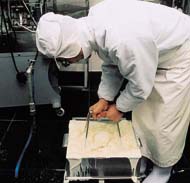
Tofu served on an Oribe dish with a lacquered spoon.
 Ôsode no mai soy beans from Hokkaido. |
 Mixing Okinawan nigari in thick soymilk. |

Melting smoothly on your tongue, a sweet flavor spreads in your mouth... This is not ice cream or custard. It’s tofu. The sweetness and full-bodied flavor of soybeans continue to amaze me. Do you know about our tofu and the secret story of how it came into being?
It began when our kitchen received some organic soybeans. We wondered how tofu produced with these beans would taste, so we took them over to a tofu maker in Kyoto. The tofu maker apologized saying, “It’s disastrous! I can’t serve this.” When we tried it, we could not believe that it was tofu. It was so sweet and creamy. It would definitely be strange served as yudôfu (“hot tofu”) or in miso soup, and would melt away, but we decided to try this new flavor, so we opened up a tofu factory behind the museum. This is how MIHO MUSEUM’s famous tofu got started.
Eventually, we began to receive soybeans from all over Japan, and when we tried using them, we found that they all possessed different properties. Among these, the soybeans from the northern regions were small and seemingly plain. However, when made into tofu, they were incredibly flavorful and sweet, and its soymilk, silky. So we made an incredibly thick soymilk with this bean, which is how we came up with this tofu. The thickness of the soymilk was 12 to 13 times that of soymilk used for most store-bought tofu. Specialty stores use soymilk that is 15 times the thickness of soymilk for regular tofu. Here, we use soymilk that is 17 times denser than the usual!
Later, someone in Okinawa, who produces natural salt, sent us natural nigari (magnesium chloride), a tofu coagulator. At that time, we had not yet found a natural substitute for the deforming additive we used. However, due to unseasonable weather last year, we were unable to produce soybeans, and though we had enough supplies to serve tofu at the museum, we could not offer our visitors tofu to take home as in the past.
As a result, our in-house tofu makers made use of this time to venture into making a tofu that uses no defoaming agent. When a defoamer is not used, the cooked beans create a lot of air bubbles, which cause tofu to be porous. Our tofu makers wondered if less beans would produce less bubbles. With this idea, they experimented by taking the lid off the pot that covered the beans in the process of cooking and mixed the beans. They then added more water before covering the pot again and kept the heat down so as not to let the beans bubble. The result was a smooth tofu that used no defoamer.
This year, we had a good harvest and again offer our tofu to take home. Please come and try our delicious tofu!


